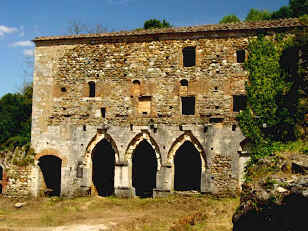
Eremo di Santa Lucia near Rosia, Siena |
|
Hermitage Rosia |
|
All that exists today at
Rosia are the ruins of the ancient Augustinian hermitage dedicated to
Santa Lucia.
The hermitage was situated just a little off the road but close enough to be visited by pilgrims. It is cut into the hillside and consisted of a Gothic church, the hermits' convento or friary, places for working and storage, a cloister (clausura) roofed over on two sides and a channel for bringing fresh water to the residents. The hermit friars always took two things into consideration when they built hermitages and then friaries: access to the road to welcome pilgrims and guests and access to water. |
Hermitage of Santa Lucia a Rosia :: Eremo di Santa Lucia a Rosia
|
Santa Lucia was part of the collection of early communities that were already in existence at the time of the formation of the Order beginning in 1244 with what is called 'the Little Union'. It was begun by a hermit
named Bonacorso somewhere around the year 1170, but seems to have been inhabited
for several centuries before. There is evidence of at least one other church beneath the present one. Tombs were found
there dating from the 10 C and walls beneath the house indicate 9 C origins.
In 1969, the site was excavated and two coins were found at the level of the second church, one from Henry II of Germany (1002) and the other of Guido Tarlato, the archbishop of Arezzo (shortly
after), suggesting occupation of the site prior to the foundation of the
hermitage. We know that Bonacorso soon attracted a number of followers because a community was already flourishing by 1200 when it is
first mentioned in written documents. |
|
|
Like the legends of
Lecceto
and Centumcelle, Rosia
lays claim to a visit from St. Augustine during the year of 387 on his way from Milan to Rome. What is certain is that its Augustinian history is attested to by the Acts of the
General Chapter of 1250, when its prior, Domenic, was elected as Econome General or General Treasurer of the Order. In all likelihood, the community adopted the Rule of St. Augustine in 1244 at the moment of the unification of the hermitages of Tuscany.
|
Back to Sovicille.
Sovicille © ammonet InfoTech 2005 - 2020 All rights reserved.